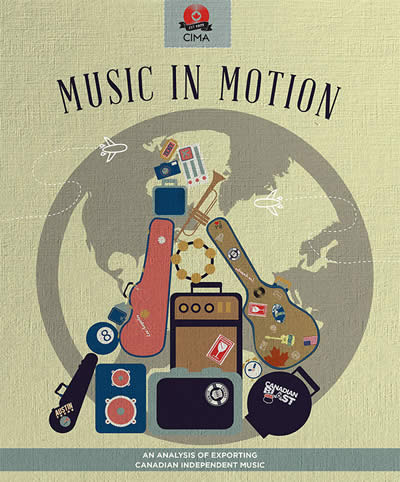CIMA Launches New Report on Canadian Music Exporting

“Music in Motion” – Canadian Indie Music Sees Great Potential Investing in Global Export
(Monday, November 28, 2016 – Toronto): The Canadian Independent Music Association (CIMA) today released a report examining how the global strategies employed by Canada's independent record labels, managers and publishers help their artists export music globally. The report also analyzes the opportunity that music export represents for Canadian music companies, revealing challenges as well as support that exists through public funding.
Music In Motion: An Analysis of Exporting Canadian Independent Music explores how exporting is a vital but expensive proposition for Canadian companies, at a critical time in the commercial music industry. Market changes over the years have increased music companies' reliance on export revenue, particularly from international touring. This results in missed or lost opportunities due to the limited capacity of companies to invest in their artists. Export barriers include: a lack of stable funding to offset higher-risk exporting, insufficient flexibility of funding programs (in terms of caps and artist-eligibility), timing (more multi-year funding is needed), and the complexity of the application process.
"Music is global and Canada must continually be on the world stage selling its music, pursuing business opportunities, and expanding the fan base," says CIMA President Stuart Johnston.
"The majority of the exporting strategies employed by the industry lack the public funding available from government programs, and the current structure of such programs is seen as a significant barrier to success. This is particularly burdensome, as the majority of the industry comprises of small businesses employing less than 15 people."
Music In Motion reveals that Canadian companies spend 21 times more on exporting for 'breakthrough artists', and these artists make up 25% of the rosters of smaller companies. This puts a greater financial burden on such independent businesses, with the prohibitive costs forcing many companies to limit their participation in export activities due to financial risks.
Music In Motion also notes that, in the majority of exporting strategies employed by the Canadian music industry, insufficient public funding is currently available from government programs. This is evidenced by the existing over-subscribed funding programs, meaning that demand far exceeds the dollars currently available. The report finds there is a clear need for the government to invest in new funding programs, and for these programs to be flexible enough to allow music companies and artists to better respond to changing market forces and opportunities.
A significant return on investment (ROI) is seen in those companies that have the ability to diversify and undertake a variety of export strategies. Public funding programs enable Canadian music companies to leverage government investment as a means of developing new strategies and broader market opportunities. Such support also enables the industry to maintain its forward momentum and to engage artists on a global scale.
CIMA commissioned Nordcity to conduct the Music In Motion study. The study was designed to provide qualitative and quantitative insight into a number of issues affecting the global exporting component of Canada's independent music industry.
Key findings from Music In Motion:
- 90% of companies surveyed were small businesses with 15 or fewer full time employees.
- Exports are extremely important to Canadian music companies, representing at least a key part of the business plan for 87% of companies, with 59% of companies viewing exports as necessary for their survival.
- Export activities can cost over twice as much as comparable domestic activities.
- An estimated $8 million to $10 million of government funding annually is used to support export activities undertaken by Canadian music companies.
- The available pool of funds to support export activities is limited and continues to become more so, while the demand for export increasingly exceeds the capacity of funders to provide that support.
- Canadian music companies do not perceive their export activities to be sufficiently supported by the existing suite of government funding programs.
- Given the increasing importance of export activities, limited public resources and declining private contributions, funding is likely to be more limited in the future.
- Prohibitive costs are the most significant barrier faced by music exporting companies, and companies reported that they limit their participation in export activities due to the significant financial risks.
- Export activities are more profitable if they are undertaken as part of a diversified export approach. Prohibitive costs and limited government funding are constraining export opportunities for less diversified music companies.
A copy of the report, Music In Motion: An Analysis of Exporting Canadian Independent Music, can be accessed for free here.
About CIMA
Established in 1975, CIMA is the not-for-profit national trade association representing the English-language, Canadian-owned segment of the music economy. CIMA advocates for a diverse membership consisting of Canadian-owned companies and their representatives, representing every facet of Canada’s music, sound recording and music-related industries.
For more information:
Jonathan MacKenzie, CIMA
Tel. (416) 485-3152 ext. 223
Email: jonathan@cimamusic.ca
www.cimamusic.ca

